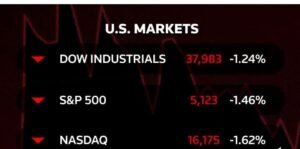On Friday, US stocks (Wall Street) experienced a significant decline following a mixed start to the earnings reporting season. Concerns over potential escalations in Middle Eastern tensions unsettled financial markets, prompting investors to seek safer investment options.
 The S&P 500 plunged by 1.5%, marking its most challenging week since October’s notable Wall Street rally. The Dow Jones Industrial Average also saw a substantial drop of 475 points, equivalent to a 1.2% decrease, while the Nasdaq composite fell by 1.6% from its previous record high.
The S&P 500 plunged by 1.5%, marking its most challenging week since October’s notable Wall Street rally. The Dow Jones Industrial Average also saw a substantial drop of 475 points, equivalent to a 1.2% decrease, while the Nasdaq composite fell by 1.6% from its previous record high.
JPMorgan Chase, despite reporting stronger-than-expected profits for the first quarter, faced a considerable setback, with its shares plummeting by 6.5%. The bank’s forecast for a key revenue source for the year fell short of Wall Street’s expectations, projecting only modest growth.
The pressure on companies to deliver robust profits is always present, but the current climate exacerbates the challenge, particularly amid concerns regarding the limited potential boost from interest rates in the near future.
Data on Wall Street to show the causation
Recent data throughout the year has indicated persistent inflation and a stronger-than-anticipated overall economic performance. Consequently, traders have revised down their expectations for Federal Reserve interest rate cuts, with market forecasts now suggesting only two cuts, a significant reduction from initial expectations of at least six cuts at the beginning of the year.
US stock indexes had already surged to record levels, partially fueled by expectations of interest rate cuts. However, without the anticipated rate cuts materializing, companies now face greater pressure to deliver larger profits to justify their current stock prices, which some critics argue appear inflated by various metrics.
The recent spike in oil prices has intensified concerns about inflationary pressures. Oil prices climbed higher on Friday amidst ongoing tensions in the Middle East, with Israel warning of potential strikes against Iran following recent incidents. Brent crude, the global benchmark, rose by 0.8% to reach $90.45 per barrel, briefly surpassing $92 during trading and returning to levels last seen in October.
Meanwhile, in the bond market, Treasury yields declined, while the price of gold increased, typical movements when investors seek refuge in safer assets. The yield on the 10-year Treasury dropped to 4.51% from 4.58% on Thursday, while gold, which has been reaching new highs, nearly reached $2,450 per ounce before moderating its gains.
Adding to market jitters, a preliminary report indicated a decline in sentiment among US consumers. This update is significant as consumer spending is a crucial driver of the US economy.
US consumers’ growing concerns about inflation, reflected in their forecasts for the next 12 months reaching the highest level since December, are raising alarm bells. Such apprehensions could fuel a self-fulfilling cycle, where preemptive purchases to mitigate future price hikes only exacerbate inflationary pressures.
Given the resilient nature of the US economy, the focus on corporate profits has intensified. While the reduced likelihood of interest rate cuts is a downside, the upside is expected to bolster sales and earnings for businesses.
 David Lefkowitz, head of U.S. equities at UBS Global Wealth Management, notes that profit growth has diversified across various sectors, moving beyond the dominance of Big Tech firms that characterized last year’s market. He forecasts the S&P 500 could potentially reach around the 5,200 level by year-end, with the possibility of even hitting 5,500 if inflationary concerns ease or corporate profit growth exceeds expectations.
David Lefkowitz, head of U.S. equities at UBS Global Wealth Management, notes that profit growth has diversified across various sectors, moving beyond the dominance of Big Tech firms that characterized last year’s market. He forecasts the S&P 500 could potentially reach around the 5,200 level by year-end, with the possibility of even hitting 5,500 if inflationary concerns ease or corporate profit growth exceeds expectations.
In the latest earnings reports, Wells Fargo experienced fluctuations, ultimately slipping by 0.4% despite beating analysts’ overall earnings forecasts. However, its net interest income fell short of expectations, impacting bank profits. Similarly, Citigroup saw a 1.7% decline despite reporting stronger-than-expected results, while State Street saw a 2.5% rise.
Overall, the S&P 500 fell by 75.65 points to close at 5,123.41, the Dow Jones Industrial Average dropped 475.84 points to 37,983.24, and the Nasdaq composite sank 267.10 points to 16,175.09.
The earnings season kicks off with a focus on banks, with analysts anticipating a third consecutive quarter of growth among S&P 500 companies, according to FactSet. Notable reports in the upcoming week include Bank of America, Johnson & Johnson, and UnitedHealth Group.
Investor attention will also be on Federal Reserve Chair Jerome Powell’s Q&A session on Tuesday, alongside a Bank of Canada governor. Additional remarks from Fed officials throughout the week could influence market expectations regarding future interest rate moves and potentially trigger further fluctuations on Wall Street.











Comments 1